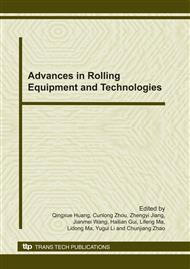[1]
Ebaugh R.L.: Chock and Roll Maintenance and Its Effect on Work Roll Bearings. Iron and Steel Engineer, Vol. 11(1978), p.64.
Google Scholar
[2]
Honeygosky M.A.: Analysis of Chock and Work Roll Bearing by Finite Element Methods. Iron and steel engineer. Vol. 1(1993), p.46.
Google Scholar
[3]
M. Li, G. X. Shen: Analysis of Load Characteristics of Large-scale Four Rows Tapered Roller Bearing. Journal of Yanshan University, Vol. 28(2004), No. 2, p.183.
Google Scholar
[4]
X. D. Shu, G. X. Shen, L. D. Zhang: Rolling Bearing Roller Plate Element Simulation of the Boundary Element Method. Journal of Chongqing Architecture University, Vol. 22(2000), No. 6, p.50. (in Chinese).
Google Scholar
[5]
Q. X. Huang, Y.G. Li, G. X. Shen et al.: Research on Even load of Multi-row Bearing of Strip Mills. Journal of Taiyuan Heavy Machinery Institute, Vol. 23(2002), No. 3, p.199. (in Chinese).
Google Scholar
[6]
Y.G. Li, Q. X. Huang, G. X. Shen, et al. Simulation of Strip Rolling Using Elasto plastic Contact BEM with Friction. Journal of Iron and Steel Research, vol. 15(2008), No. 1, p.34.
DOI: 10.1016/s1006-706x(08)60008-4
Google Scholar
[7]
X. D. Shu, G. X. Shen: Analysis of Load Characteristic of Roller Bearing on Work Roll for an Aluminum foil mill. HHeavy MachineryH, Vol. 5(2003), p.20. (in Chinese).
Google Scholar
[8]
V. Rokhlin. Rapid solution of integral equations of classical potential theory. Comput. Phys., vol. 60(1985), p.187.
Google Scholar
[9]
L. Greengard, V. Rokhlin: A Fast algorithm for particle simulations, J. Comput. Phys. vol. 73 (1987), p.325.
Google Scholar
[10]
L. Greengard and V. Rokhlin: A new version of the fast multipole method for the Laplace equation in three dimension , Acta Numer. vol. 6(1997), p.229.
DOI: 10.1017/s0962492900002725
Google Scholar
[11]
G. X. Shen, D. Y. Liu, C. X. Yu: Fast Multipole Boundary Element Method and Rolling Engineering. Beijing: Science Press, (2005).
Google Scholar
[12]
A. P. Peirce, J. A. L. Napier: A Spectral Multipole Method for Efficient Solution of Large-scale Boundary Element Models in Elastostatic, Int.J. Numer. Meth. Engng. Vol. 38(1995), p.4009.
DOI: 10.1002/nme.1620382307
Google Scholar
[13]
A. S. Sangani, G. Mo: An ( )O N Algorithm for Stokes and Laplace Interaction of Particles. Phys. Fluid. Vol. 8(1996), p. (1990).
Google Scholar
[14]
H. L. Gui, Q. X. Huang, L. F. Ma, et al.: Application of FM-BEM in rolled piece deformation analysis of straightening process. Journal of Chongqing University, Vol. 33(2010) No. 5, p.98. (in Chinese).
Google Scholar
[15]
H. L. Gui, Q. X. Huang. The mixed fast multipole boundary element method for solving strip cold rolling process. Applied Mechanics and Material. Vol. 20-23(2010), p.76.
DOI: 10.4028/www.scientific.net/amm.20-23.76
Google Scholar
[16]
H. L. Gui, Q. X. Huang, Y. M. Chen: Analysis of the Contact Problems using Mixed Fast Multipole Boundary Element Method. ICIC Express Letters, Vol. 4(2010) No. 3, p.1281.
Google Scholar


